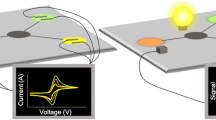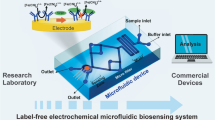Abstract
This article reviews advances over the last five years in microfluidics and microchip-electrophoresis techniques for detection of clinical biomarkers. The variety of advantages of miniaturization compared with conventional benchtop methods for detecting biomarkers has resulted in increased interest in developing cheap, fast, and sensitive techniques. We discuss the development of applications of microfluidics and microchip electrophoresis for analysis of different clinical samples for pathogen identification, personalized medicine, and biomarker detection. We emphasize the advantages of microfluidic techniques over conventional methods, which make them attractive future diagnostic tools. We also discuss the versatility and adaptability of this technology for analysis of a variety of biomarkers, including lipids, small molecules, carbohydrates, nucleic acids, proteins, and cells. Finally, we conclude with a discussion of aspects that need to be improved to move this technology towards routine clinical and point-of-care applications.








Similar content being viewed by others
References
Harrison DJ, Manz A, Fan Z, Lüdi H, Widmer HM (1992) Capillary electrophoresis and sample injection systems integrated on a planar glass chip. Anal Chem 64:1926–1932
Gordon J, Michel G (2012) Discerning trends in multiplex immunoassay technology with potential for resource-limited settings. Clin Chem 58:690–698
van der Meel R, Krawczyk-Durka M, van Solinge WW, Schiffelers RM (2014) Toward routine detection of extracellular vesicles in clinical samples. Int J Lab Hematol 36:244–253
Nahavandi S, Baratchi S, Soffe R, Tang SY, Nahavandi S, Mitchell A, Khoshmanesh K (2014) Microfluidic platforms for biomarker analysis. Lab Chip 14:1496–1514
Yang Z, Sweedler JV (2014) Application of capillary electrophoresis for the early diagnosis of cancer. Anal Bioanal Chem 406:4013–4031
Oita I, Halewyck H, Thys B, Rombaut B, Vander Heyden Y, Mangelings D (2010) Microfluidics in macro-biomolecules analysis: macro inside in a nano world. Anal Bioanal Chem 398:239–264
Zare RN, Kim S (2010) Microfluidic platforms for single-cell analysis. Annu Rev Biomed Eng 12:187–201
Jokerst JC, Emory JM, Henry CS (2012) Advances in microfluidics for environmental analysis. Analyst 137:24–34
Kenyon SM, Meighan MM, Hayes MA (2011) Recent developments in electrophoretic separations on microfluidic devices. Electrophoresis 32:482–493
Mohammed MI, Desmulliez MPY (2011) Lab-on-a-chip based immunosensor principles and technologies for the detection of cardiac biomarkers: a review. Lab Chip 11:569–595
Wisitsoraat A, Sritongkham P, Karuwan C, Phokharatkul D, Maturos T, Tuantranont A (2010) Fast cholesterol detection using flow injection microfluidic device with functionalized carbon nanotubes based electrochemical sensor. Biosens Bioelectron 26:1514–1520
Ali MA, Srivastava S, Solanki PR, Agrawal VV, John R, Malhotra BD (2012) Nanostructured anatase-titanium dioxide based platform for application to microfluidics cholesterol biosensor. Appl Phys Lett 101:084105
Labroo P, Cui Y (2014) Graphene nano-ink biosensor arrays on a microfluidic paper for multiplexed detection of metabolites. Anal Chim Acta 813:90–96
Bai HY, Lin SL, Chung YT, Liu TY, Chan SA, Fuh MR (2011) Quantitative determination of 8-isoprostaglandin F(2α) in human urine using microfluidic chip-based nano-liquid chromatography with on-chip sample enrichment and tandem mass spectrometry. J Chromatogr A 1218:2085–2090
Takai M, Nagai M, Morimoto Y, Sasao K, Oki A, Nakanishi J, Inokuchi H, Chang CH, Kikuchi J, Ogawa H, Horiike Y (2013) Colorimetric microchip assay using our own whole blood collected by a painless needle for home medical care. Analyst 138:6469–6476
Heller A, Feldman B (2008) Electrochemical glucose sensors and their applications in diabetes management. Chem Rev 108:2482–2505
Cai L, Wang Y, Wu Y, Xu C, Zhong M, Lai H, Huang J (2014) Fabrication of a microfluidic paper-based analytical device by silanization of filter cellulose using a paper mask for glucose assay. Analyst 139:4593–4598
Yu J, Ge L, Huang J, Wang S, Ge S (2011) Microfluidic paper-based chemiluminescence biosensor for simultaneous determination of glucose and uric acid. Lab Chip 11:1286–1291
Lin YH, Wang SH, Wu MH, Pan TM, Lai CS, Luo JD, Chiou CC (2013) Integrating solid-state sensor and microfluidic devices for glucose, urea and creatinine detection based on enzyme-carrying alginate microbeads. Biosens Bioelectron 43:328–335
Chen D, Mauk M, Qiu X, Liu C, Kim J, Ramprasad S, Ongagna S, Abrams WR, Malamud D, Corstjens PLAM, Bau HH (2010) An integrated, self-contained microfluidic cassette for isolation, amplification, and detection of nucleic acids. Biomed Microdevices 12:705–719
Ferguson BS, Buchsbaum SF, Wu TT, Hsieh K, Xiao Y, Sun R, Soh HT (2011) Genetic analysis of H1N1 influenza virus from throat swab samples in a microfluidic system for point-of-care diagnostics. J Am Chem Soc 133:9129–9135
Wang CH, Lien KY, Hung LY, Lei HY, Lee GB (2012) Integrated microfluidic system for the identification and multiple subtyping of influenza viruses by using a molecular diagnostic approach. Microfluid Nanofluid 13:113–123
Danila DC, Fleisher M, Scher HI (2011) Circulating tumor cells as biomarkers in prostate cancer. Clin Cancer Res 17:3903–3912
Thierry B, Kurkuri M, Shi JY, Lwin LEMP, Palms D (2010) Herceptin functionalized microfluidic polydimethylsiloxane devices for the capture of human epidermal growth factor receptor 2 positive circulating breast cancer cells. Biomicrofluidics 4:032205
Issadore D, Chung J, Shao H, Liong M, Ghazani AA, Castro CM, Weissleder R, Lee H (2012) Ultrasensitive clinical enumeration of rare cells ex vivo using a micro-hall detector. Sci Transl Med 4:141ra92
Berneis K, Jeanneret C, Muser J, Felix B, Miserez AR (2005) Low-density lipoprotein size and subclasses are markers of clinically apparent and non-apparent atherosclerosis in type 2 diabetes. Metabolism 54:227–234
Hopewell JC, Seedorf U, Farrall M, Parish S, Kyriakou T, Goel A, Hamsten A, Collins R, Watkins H, Clarke R, Consortium P (2014) Impact of lipoprotein(a) levels and apolipoprotein(a) isoform size on risk of coronary heart disease. J Intern Med 276:260–268
DeFilippis AP, Blaha MJ, Martin SS, Reed RM, Jones SR, Nasir K, Blumenthal RS, Budoff MJ (2013) Nonalcoholic fatty liver disease and serum lipoproteins: the multi-ethnic study of atherosclerosis. Atherosclerosis 227:429–436
Llanos AA, Makambi KH, Tucker CA, Wallington SF, Shields PG, Adams-Campbell LL (2012) Cholesterol, lipoproteins, and breast cancer risk in African American women. Ethn Dis 22:281–287
Williams PT, Zhao XQ, Marcovina SM, Otvos JD, Brown BG, Krauss RM (2014) Comparison of four methods of analysis of lipoprotein particle subfractions for their association with angiographic progression of coronary artery disease. Atherosclerosis 233:713–720
Garber DW, Kulkarni KR, Anantharamaiah GM (2000) A sensitive and convenient method for lipoprotein profile analysis of individual mouse plasma samples. J Lipid Res 41:1020–1026
Otvos JD, Jeyarajah EJ, Bennett DW, Krauss RM (1992) Development of a proton nuclear magnetic resonance spectroscopic method for determining plasma lipoprotein concentrations and subspecies distributions from a single, rapid measurement. Clin Chem 38:1632–1638
Ruecha N, Siangproh W, Chailapakul O (2011) A fast and highly sensitive detection of cholesterol using polymer microfluidic devices and amperometric system. Talanta 84:1323–1328
Wang H, Wang D, Wang J, Wang H, Gu J, Han C, Jin Q, Xu B, He C, Cao L, Wang Y, Zhao J (2009) Application of poly(dimethylsiloxane)/glass microchip for fast electrophoretic separation of serum small, dense low-density lipoprotein. J Chromatogr A 1216:6343–6347
Tyurin VA, Tyurina YY, Borisenko GG, Sokolova TV, Ritov VB, Quinn PJ, Rose M, Kochanek P, Graham SH, Kagan VE (2000) Oxidative stress following traumatic brain injury in rats: quantitation of biomarkers and detection of free radical intermediates. J Neurochem 75:2178–2189
Cracowski JL, Ormezzano O (2004) Isoprostanes, emerging biomarkers and potential mediators in cardiovascular diseases. Eur Heart J 25:1675–1678
Gibson LR II, Bohn PW (2013) Non-aqueous microchip electrophoresis for characterization of lipid biomarkers. Interface Focus 3:20120096
Leymarie N, Griffin PJ, Jonscher K, Kolarich D, Orlando R, McComb M, Zaia J, Aguilan J, Alley WR, Altmann F, Ball LE, Basumallick L, Bazemore-Walker CR, Behnken H, Blank MA et al (2013) Interlaboratory study on differential analysis of protein glycosylation by mass spectrometry: the ABRF glycoprotein research multi-institutional study 2012. Mol Cell Proteomics 12:2935–2951
Morelle W, Michalski JC (2007) Analysis of protein glycosylation by mass spectrometry. Nat Protoc 2:1585–1602
Mitra I, Alley WR, Goetz JA, Vasseur JA, Novotny MV, Jacobson SC (2013) Comparative profiling of N-glycans isolated from serum samples of ovarian cancer patients and analyzed by microchip electrophoresis. J Proteome Res 12:4490–4496
Zhuang Z, Starkey JA, Mechref Y, Novotny MV, Jacobson SC (2007) Electrophoretic analysis of N-glycans on microfluidic devices. Anal Chem 79:7170–7175
Nagata H, Itoh T, Baba Y, Ishikawa M (2010) Highly sensitive detection of monosaccharides on microchip electrophoresis using pH discontinuous solution system. Anal Sci 26:731–736
Sadee W, Dai Z (2005) Pharmacogenetics/genomics and personalized medicine. Hum Mol Genet 14:R207–R214
Pirmohamed M (2006) Warfarin: almost 60 years old and still causing problems. Br J Clin Pharmacol 62:509–511
Poe BL, Haverstick DM, Landers JP (2012) Warfarin genotyping in a single PCR reaction for microchip electrophoresis. Clin Chem 58:725–731
Madsen BE, Villesen P, Wiuf C (2008) Short tandem repeats in human exons: a target for disease mutations. BMC Genomics 9:410
Le Roux D, Root BE, Hickey JA, Scott ON, Tsuei A, Li J, Saul DJ, Chassagne L, Landers JP, de Mazancourt P (2014) An integrated sample-in-answer-out microfluidic chip for rapid human identification by STR analysis. Lab Chip 14:4415–4425
Jin S, Anderson GJ, Kennedy RT (2013) Western blotting using microchip electrophoresis interfaced to a protein capture membrane. Anal Chem 85:6073–6079
Wang D, Bodovitz S (2010) Single cell analysis: the new frontier in 'omics'. Trends Biotechnol 28:281–290
Hughes AJ, Spelke DP, Xu Z, Kang CC, Schaffer DV, Herr AE (2014) Single-cell western blotting. Nat Methods 11:749–755
Kang CC, Lin JMG, Xu Z, Kumar S, Herr AE (2014) Single-cell western blotting after whole-cell imaging to assess cancer chemotherapeutic response. Anal Chem 86:10429–10436
Murphy MP, LeVine H 3rd (2010) Alzheimer's disease and the amyloid-beta peptide. J Alzheimers Dis 19:311–323
Mohamadi MR, Svobodova Z, Verpillot R, Esselmann H, Wiltfang J, Otto M, Taverna M, Bilkova Z, Viovy JL (2010) Microchip electrophoresis profiling of Aβ peptides in the cerebrospinal fluid of patients with Alzheimer's disease. Anal Chem 82:7611–7617
Huang G, Ouyang J, Delanghe JR, Baeyens WRG, Dai Z (2004) Chemiluminescent image detection of haptoglobin phenotyping after polyacrylamide gel electrophoresis. Anal Chem 76:2997–3004
Maes M, Delanghe J, Bocchio Chiavetto L, Bignotti S, Tura GB, Pioli R, Zanardini R, Altamura CA (2001) Haptoglobin polymorphism and schizophrenia: genetic variation on chromosome 16. Psychiatry Res 104:1–9
Hochberg I, Roguin A, Nikolsky E, Chanderashekhar PV, Cohen S, Levy AP (2002) Haptoglobin phenotype and coronary artery collaterals in diabetic patients. Atherosclerosis 161:441–446
Huang B, Huang C, Liu P, Wang F, Na N, Ouyang J (2011) Fast haptoglobin phenotyping based on microchip electrophoresis. Talanta 85:333–338
Whiteaker JR, Zhao L, Anderson L, Paulovich AG (2010) An automated and multiplexed method for high throughput peptide immunoaffinity enrichment and multiple reaction monitoring mass spectrometry-based quantification of protein biomarkers. Mol Cell Proteomics 9:184–196
Kalish H, Phillips TM (2012) Assessment of chemokine profiles in human skin biopsies by an immunoaffinity capillary electrophoresis chip. Methods 56:198–203
Acknowledgements
Funding for this work was provided by the National Institutes of Health under grant R01 EB006124.
Author information
Authors and Affiliations
Corresponding author
Additional information
Published in the topical collection Capillary Electrophoresis of Biomolecules with guest editor Lisa Holland.
Rights and permissions
About this article
Cite this article
Pagaduan, J.V., Sahore, V. & Woolley, A.T. Applications of microfluidics and microchip electrophoresis for potential clinical biomarker analysis. Anal Bioanal Chem 407, 6911–6922 (2015). https://doi.org/10.1007/s00216-015-8622-5
Received:
Revised:
Accepted:
Published:
Issue Date:
DOI: https://doi.org/10.1007/s00216-015-8622-5




